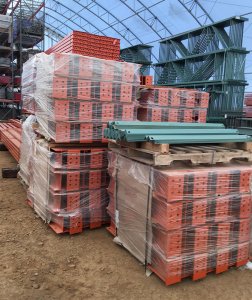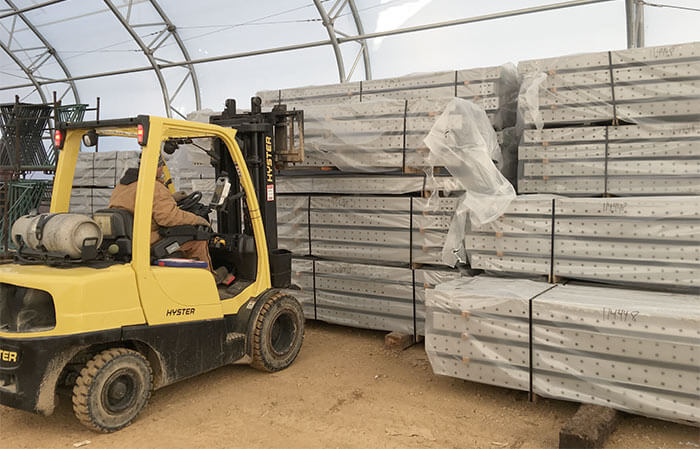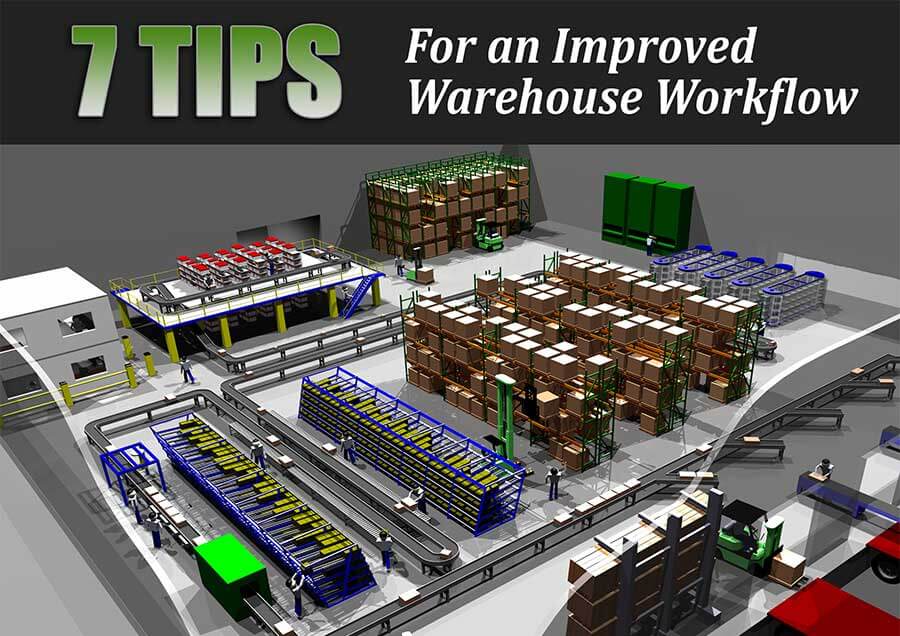
Company Info
Information about the everyday goings on at SJF Material Handling.
Employee Spotlight – Ed Salonek
 Today in our Employee Spotlight is Ed Salonek, Chief Financial Officer and Human Resources Manager. Ed is a busy guy but always seems to have a smile on his face and something to joke about.
Today in our Employee Spotlight is Ed Salonek, Chief Financial Officer and Human Resources Manager. Ed is a busy guy but always seems to have a smile on his face and something to joke about.
It’s not unusual to see him here in the office on a weekend or an evening and even then, he’s smiling. Having one full time position is enough for most people but Ed takes care of two departments, and important ones at that. I’m sure he wonders occasionally what he’s gotten himself into as “Ed the HR Manager,” but what keeps us on the straight and narrow is that we know he’s also “Ed the Controller,” who makes sure all of us
employees get paid. 🙂
Name: Ed Salonek
Title: Controller Chief Financial Officer and Human Resources Manager
When did you start working at SJF?: 2006
What do you like most about working at SJF? I enjoy the mixture of accounting and programming\customization with Epicor.
What do you enjoy doing when you’re not at work? Camping, watching Wild hockey, hunting with Mocha
What’s your favorite day? Saturday
Biggest pet peeve? Lazy people.
Name something about you, that people would be surprised to know: I like to work, got it from my parents.
SJF Christmas Celebration and Awards 2017
Every year, SJF likes to treat our hard-working employees to a catered meal and awards ceremony to commemorate the accomplishments of a year’s worth of dedication. The year 2017 has been a particularly successful one for SJF, thanks to the dedication and hard work of all our employees, who work together each and every day to make sure our customers are our top priority.
We are who we are because of the men and women we call our SJF family!
Sales Awards
SJF had some outstanding sales in 2017. All of our sales people sold over $1 million dollars worth of material handling equipment to our loyal customer base.
Winning the top sales award this year was Eric Thovson (ET) for the second year in a row, followed by Kendal Kalamaha and Jason Dieter. Way to go!!

Anniversaries

We also like to celebrate anniversaries with the company and are proud that the majority of our employees have been employed with SJF for 10+ years. This year marked an important anniversary for one of our long-term employees, Dave Kieper, who has been with our company for an impressive 25 years. Thanks for all you do Dave!
More photos of our celebration
New Pennsylvania Quick-Ship Stocking Location for Cantilever Racks
SJF Material Handling Inc. Announces New Pennsylvania Stocking Location for Cantilever Racks & Structural Storage Systems
 SJF’s multiple Quick-Ship locations provide clients easy access to 72-hour shipping on structural cantilever racks. This product historically requires 8 to 12 week wait times.

Winsted, MN (PRWEB) September 30, 2017 – SJF Material Handling Inc., in cooperation with US manufacturing partner Ross Technologies, announced the opening of its Pennsylvania stocking quick ship location for its full line of cantilever storage rack products. In addition to providing “72-Hour Quick-Ship†availability on its most popular sizes and capacities of cantilever racks, several new products & design enhancements to other storage products are currently in production and expected for release this fall.
In Jan. 2017, SJF Material Handling, Winsted, MN announced a strategic partnership with USA Manufacturer Ross Technologies as the companies preferred manufacturer of its structural steel storage rack products. SJF stocks and distributes a wide variety of storage rack products sold through its online e-store and brick & mortar retail locations.
This newest SJF offering of structural cantilever rack products has quickly gained national acclaim as a premier storage solution. Cantilever racks are ideal for storing items inherently too long, bulky or lightweight to store using conventional warehouse racks or shelving. SJF’s latest offering of heavy duty structural cantilever racks is ideal for storing everything from lumber & steel to boats, autos, pipe, coils and more.
According to SJF President Stafford Sterner, the company’s newest offerings of rack storage solutions provide its clients all the benefits of traditional warehouse storage rack systems without many of the drawbacks & limitations traditionally associated with these older legacy storage systems.
One of the initial challenges was the ability to offer our clients a heavy-duty cantilever storage rack solution that was engineered and manufactured in the USA and would meet and exceed the most stringent requirements for strength and durability. Working with USA manufacturers, SJF provides clients a quality cantilever rack product that can now be shipped anywhere in the USA in a matter of hours vs. weeks or months. SJF’s structural cantilever racks are flexible, allowing storage of several sizes of material within the same rack system yet versatile enough to carry a wide array of loads.
Several new design enhancements have been incorporated in the manufacturing process eliminating any positioning issues. According to Sterner, the latest design enhancements have taken an excellent product and made it even better. With the addition of providing 72-hour quick-ship on an extensive offering of sizes and capacities, we can provide our clients with a product and service you won’t find anywhere else in the industry. Initial feedback from clients has been very positive. Users find the “quick-ship†delivery an incredible value.
Find out more and see detailed photos, videos and product information about cantilever rack at SJF Material Handling’s website.
Employee Spotlight – Jason Deiter
 Today in our Employee Spotlight is Jason Deiter, Senior Sales Specialist. Jason is our longest running Sales Specialist here at SJF, so it’s safe to say he knows the material handling business very well.
Today in our Employee Spotlight is Jason Deiter, Senior Sales Specialist. Jason is our longest running Sales Specialist here at SJF, so it’s safe to say he knows the material handling business very well.
Jason is also a local celebrity (although he would strongly disagree with that statement and will probably ask for it to be removed). As a member of the local band Rize and as a solo musician, he’s in front of crowds singing his heart out and playing guitar on a regular basis. You would think that he would put on an impromptu show every now and then for the rest of the SJF employees but we’re still waiting for that day.
Title: Senior Sales Specialist
When did you start working at SJF? In 1991, then took a 5 year break and came back to SJF in 1996.
What do you like most about working at SJF? Flexibility, opportunity and coworkers.
What do you enjoy doing when you’re not at work? Singing, playing guitar, camping, motorcycling, school activities with kids.
What’s your favorite day? May 9th. It’s my birthday and I took it off for the first time this year. I like it so much that I have decided to make it a habit. Everybody should take their birthday off.
Biggest pet peeve? Dirty dishes in or around the sink.
Name something about you that people would be surprised to know: Though I fly, I am afraid to fly.
What question would you like to answer that you didn’t get asked? What is my favorite color? I have had 4 blue vehicles, 4 blue motorcycles and 3 blue guitars.
7 Tips for an Improved Warehouse Workflow
From managing logistics and layout to ensuring optimal safety and efficiency, warehouse workflow is more than just the speed of output. A quality warehouse manager knows how to utilize their best tools to achieve maximum optimization but even the elite need a refresher of best practices to keep things running smooth.
Here’s our list of 7 Tips for an Improved Warehouse Workflow:
1. Laying out the warehouse for optimum space utilization
The most important job of any warehouse manager is to determine how to best use the available floor space to store and move product. Especially in high dollar real estate markets, every inch counts! Ideally, the process begins with a complete drawing of the space including posts, sprinklers, windows, doors and any other architectural fixtures that will have to be taken into account. Then, the warehouse manager must clearly understand the inbound and outbound operations with the goal of maximizing space utilization while also saving time and reducing errors as product is moved in and out of the warehouse.
2. Using the proper type of storage systems
Choosing the proper type of storage system is an essential component of warehouse workflow efficiency. Understanding what is being stored, how much of it is being stored and how often it needs to be accessed will determine the most efficient storage system to use. Factors such as product expiration, temperature requirements and product demand must also be factored into the type of storage system chosen. Storage systems can be mixed and matched to meet the various product rotation needs within the warehouse. The speed and frequency of vehicles (such as forklifts) moving through the warehouse will dictate the durability requirements of any storage system.
3. Picking optimization
Within the warehouse layout, pick routes must be carefully planned. Minimizing travel through the warehouse will result in significant time savings and reduced potential for accidents. No matter how large the warehouse is, the amount of time spent picking product represents a significant part of costs. Organizing pick routes to match pick lists is a great way to reduce going back and forth through the aisles.
4. Properly managing inventory
A surprising number of companies do not know exactly how much inventory they have and exactly where it is stored. It is impossible to run an efficient workflow without this knowledge. More organizations that do a good job of inventory management are adopting lean inventory practices—only storing what is actually needed. The benefits of lean inventory management include time savings and waste reduction which translate to cost savings. Inventory must always be properly labelled to ensure proper counting, storage and retrieval. There are a number of different ways to keep track of inventory, from manual processes to highly automated, integrated systems.
5. Using Technology
While some companies are still using spreadsheets and other manual systems to manage their operations, the vast majority have adopted at least some technology to help them manage their warehouse. There are a plethora of WMS (warehouse management system) options available today that can help you manage standard as well as daily tasks such including labor, inventory, order processing, SKU handling, stock location and more. WMS’s can be standalone systems or part of a full ERP (enterprise resource planning) system. Always make sure WMS modules are linked and integrated to ensure smooth operation of the system as a whole and that users are fully trained on all software systems. Aligning IT and operations for a common understanding of business processes is a must.
6. Keeping the Warehouse Tidy and Orderly
Cluttered and disorderly aisles not only create safety hazards, they greatly impede the ability to move through the warehouse efficiently. Allocating even a little bit of time every day to clearing the aisles will immediately improve workflow. Consider posting SOP’s where appropriate, within the warehouse.
7. Maintaining Health and Safety Best Practices (including training)
Worker safety is of utmost importance to any company. Making sure workers are fully trained to do their jobs before they start doing them is always the best practice. Spending more time training will pay back many times over in not only accident reduction but error reduction as well. Consider cross-training workers to be able to perform more than one type of job so you can keep your operation moving at all times. Provide refresher training to make sure all workers are current in your processes and work standards. Clearly marking travel paths, for forklifts and people, and keeping them clear of clutter is essential to creating a safe work environment. Having proper lighting will reduce potential errors in product picking as well as improve the overall environment for the workers. Posting health and safety rules and regulations where everyone can see them is required by law.
Optimizing warehouse workflow is essential to optimizing profits. As inventory and storage needs change, warehouse design should be revisited and amended as practically as possible.
About the Author: Jeff Howard is the VP of Sales for Advance Storage Products, a structural rack systems manufacturer. Jeff has over 15 years in the material handling industry and holds a BA in Economics from Denison University.
New Ways to Sign Up for the SJF Industry Insider
Now we’re making it even easier than ever…
 Stay ahead of the crowd – join our Industry Insider mailing list today and be the first to hear of new equipment purchases and special member-only discounts. You’ll receive a new mailing once or twice a month with our latest and greatest updates and information. You’ll also have access to our full library of tutorial guides, giving you on-the-spot information and how-tos to keep your home, workplace or warehouse in top form.
Stay ahead of the crowd – join our Industry Insider mailing list today and be the first to hear of new equipment purchases and special member-only discounts. You’ll receive a new mailing once or twice a month with our latest and greatest updates and information. You’ll also have access to our full library of tutorial guides, giving you on-the-spot information and how-tos to keep your home, workplace or warehouse in top form.
Remember, you can unsubscribe at any time, no questions asked.
Employee Spotlight – Joe Bachel
Today in our Employee Spotlight is Joe Bachel, SJF’s Yard Supervisor and Mechanic Extraordinaire. Joe is a man of few words, but lucky for us at SJF, he’s also full of unending experience and knowledge (and maybe something else 😉 ). He can fix anything!
Name: Joe Bachel
Title: Yard Supervisor/Mechanic
When did you start working at SJF? In May of 1993
What do you like most about working at SJF? Never a dull moment.
What do you enjoy doing when you’re not at work? Working on my “toys” at home.
What’s your favorite day? Friday
Biggest pet peeve? Having to re-do things.
Name something about you, that people would be surprised to know: Nothing, I am an open book.



















